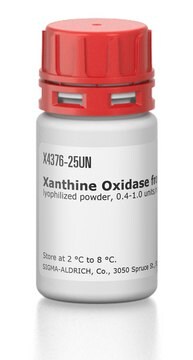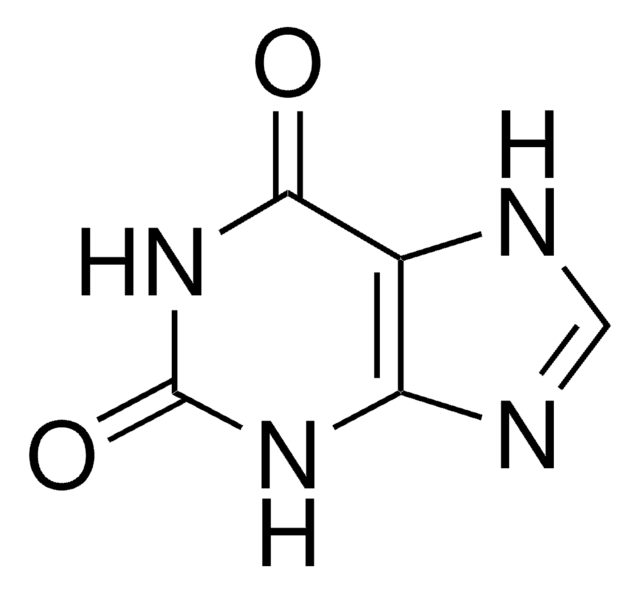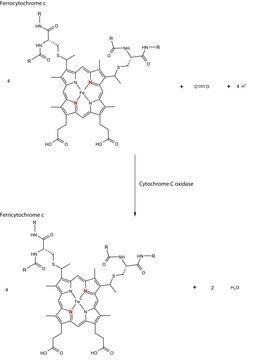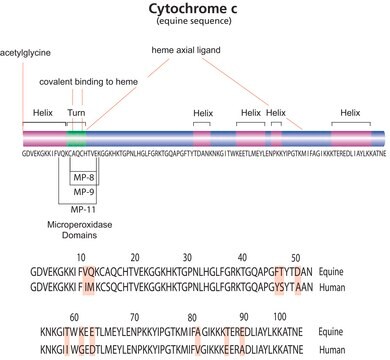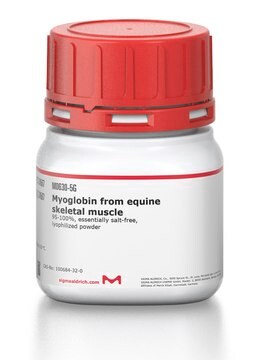C6749
Cytochrome c equine
recombinant, expressed in E. coli
Anmeldenzur Ansicht organisationsspezifischer und vertraglich vereinbarter Preise
Alle Fotos(1)
About This Item
Empfohlene Produkte
Biologische Quelle
horse
Qualitätsniveau
Rekombinant
expressed in E. coli
Assay
≥95% (SDS-PAGE)
Form
powder
UniProt-Hinterlegungsnummer
Lagertemp.
−20°C
Angaben zum Gen
horse ... CYCS(100053958)
Anwendung
Cytochrome c polymerization occurs by successive domain swapping, which may be a common mechanism of protein polymerization. Cytochrome c has been used in a study to establish that an optimized pulsed-Q dissociation and collision-activated dissociation hybrid workflow may have wide applications in biological and biomedical research.
Biochem./physiol. Wirkung
Cytochrom c ist in erster Linie als mitochondriales Protein mit Elektronencarrier Funktion bekannt. Der Übergang von Cytochrom c zwischen Eisen(II) und Eisen(III) innerhalb der Zelle macht es zu einem effizienten biologischen Elektronen-Transporter, und es spielt eine wichtige Rolle bei zellulären Oxidationen in Pflanzen und Tieren. Es wird allgemein als universeller Atmungskatalysator betrachtet, der eine wesentliche Elektronen-Brücke zwischen den lungengängigen Substraten und Sauerstoff bildet.
Cytochrome c has been identified as an important mediator in apoptotic pathways. The release of mitochondrial cytochrome c into the cytoplasm stimulates apoptosis and is commonly used as an indicator of the apoptotic process in the cell.
Angaben zur Herstellung
Produced using animal component-free materials.
Sonstige Hinweise
Für weitere Informationen sehen Sie cytochrome c and electron transport at www.sigma-aldrich.com/enzymeexplorer.
Lagerklassenschlüssel
11 - Combustible Solids
WGK
WGK 3
Flammpunkt (°F)
Not applicable
Flammpunkt (°C)
Not applicable
Hier finden Sie alle aktuellen Versionen:
Analysenzertifikate (COA)
Lot/Batch Number
Die passende Version wird nicht angezeigt?
Wenn Sie eine bestimmte Version benötigen, können Sie anhand der Lot- oder Chargennummer nach einem spezifischen Zertifikat suchen.
Besitzen Sie dieses Produkt bereits?
In der Dokumentenbibliothek finden Sie die Dokumentation zu den Produkten, die Sie kürzlich erworben haben.
Kunden haben sich ebenfalls angesehen
Ramil F Latypov et al.
Journal of molecular biology, 383(2), 437-453 (2008-09-02)
Despite close structural similarity, the ferric and ferrous forms of cytochrome c differ greatly in terms of their ligand binding properties, stability, folding, and dynamics. The reduced heme iron binds diatomic ligands such as CO only under destabilizing conditions that
Ying Dong et al.
Clinical cancer research : an official journal of the American Association for Cancer Research, 15(1), 131-139 (2009-01-02)
beta-Lapachone (ARQ 501, a formulation of beta-lapachone complexed with hydroxypropyl-beta-cyclodextrin) is a novel anticancer agent with selectivity against prostate cancer cells overexpressing the NAD(P)H:quinone oxidoreductase-1 enzyme. Lack of solubility and an efficient drug delivery strategy limits this compound in clinical
Tiannan Guo et al.
Journal of proteome research, 7(11), 4831-4840 (2008-10-08)
Coupling of multiplex isobaric tags for relative and absolute quantitation (iTRAQ) to a sensitive linear ion trap (LTQ) mass spectrometer (MS) is a challenging, but highly promising approach for quantitative high-throughput proteomic profiling. Integration of the advantages of pulsed-Q dissociation
Shun Hirota et al.
Proceedings of the National Academy of Sciences of the United States of America, 107(29), 12854-12859 (2010-07-10)
Cytochrome c (cyt c) is a stable protein that functions in a monomeric state as an electron donor for cytochrome c oxidase. It is also released to the cytosol when permeabilization of the mitochondrial outer membrane occurs at the early
Dorival Martins et al.
Frontiers in microbiology, 11, 576708-576708 (2020-10-27)
Stressors and environmental cues shape the physiological state of bacteria, and thus how they subsequently respond to antibiotic toxicity. To understand how superoxide stress can modulate survival to bactericidal antibiotics, we examined the effect of intracellular superoxide generators, paraquat and
Protokolle
Separation of HPLC protein standard mixture, analytical standard
Unser Team von Wissenschaftlern verfügt über Erfahrung in allen Forschungsbereichen einschließlich Life Science, Materialwissenschaften, chemischer Synthese, Chromatographie, Analytik und vielen mehr..
Setzen Sie sich mit dem technischen Dienst in Verbindung.
